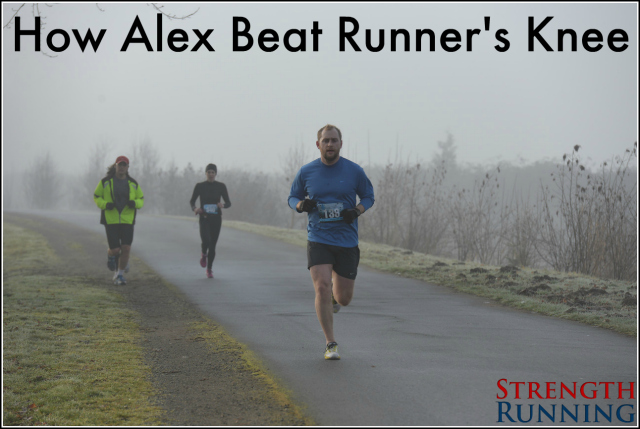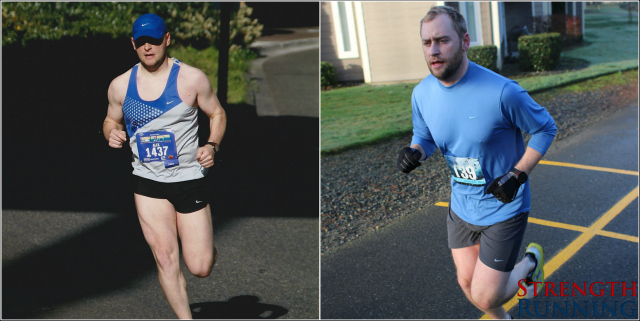The top mistake I see runners make is not fixing an easily fixable problem. It makes intuitive sense, right?

But I hear some variation of this almost every day:
It’s now been 3+ months (and two months of PT) and I’m still unable to run even a few minutes without significant pain. I very much want to get back to my normal running routine and maybe try some trail running and even longer distances.
These runners have big, ambitious goals. But ongoing injuries are preventing them from realizing their potential.
I’m not too surprised since the common treatment options are virtually worthless:
- “Just rest until it doesn’t hurt anymore.”
- “Stretch more!”
- “Your body isn’t built for running.”
If you’ve ever heard one of those lines from a PCP or other specialist, you know how frustrating it can be! But there IS a better way…
Today I’d like to share a similar story – one that’s probably familiar to you.
Meet Alex. Over the years suffered through almost every injury you can imagine: shin splints, IT band issues, plantar fasciitis, and even a stress fracture, not to mention constant nagging aches and pains.
During 6 months of ongoing knee pain in 2014, Alex tried just about everything: he stopped running for a month, used ice and ibuprofen, saw several doctors, and had all sorts of testing done.
The results of those tests? Inconclusive. Can you imagine?! Alex told me:
At the end of the day, I was told there wasn’t anything definitively wrong with my knee.
And as I’m sure you can imagine, he felt frustrated and dejected.
But soon things were about to change.
“A chance at running well into old age was a no-brainer”
Alex’s running was at an all-time low by September of 2014. His training was monotonous and this led him to ongoing injuries and unrealized goals.
He wrote his own training plans and admits they consisted of running and nothing else. Not only that, but there was minimal variety in the paces he ran and the terrain he chose. Alex’s strength work was limited and not running specific.
Alex told me about his typical approach:
I’d write up a training plan that spanned roughly 3 months with a goal race at the end, usually a half marathon. My weekly mileage would start around 10-15 miles/week and I’d increase it according to the 10% rule until I was around 35-40 miles.
I incorporated very little strength work, warm-ups, or cool downs. I also did almost no core work whatsoever.
The only thing that changed from day to day was the distance down the road I went before I turned around.
When Alex started running, he spent the first month at a slower pace but by the second month that got boring and his average pace per mile would increase by as much as a minute.
At those paces, he was probably pushing too hard for his easy days. And he spent zero time at his goal race pace!
Looking back, Alex acknowledges “for some reason I believed this training plan would get me to my goal.”
While this type of training may not look too unusual to the average runner, it raises a number of red flags. Alex’s nagging injuries and inability to get through a training cycle successfully were the principal signs that something needed to change.
But after discovering Strength Running, he started learning about all the different ways he could improve his running and believed in the SR philosophy.
When it came to purchasing an injury prevention program, he felt that he had nothing to lose:
Honestly, at the depressed point I was at when I found your program, there weren’t many barriers to investing in the program.
I want to keep running well into my old age because it’s one of my absolute favorite activities. Paying a nominal fee for a chance at that was a no-brainer.
And soon, Alex would experience what it was like to run healthy without pain.
No pain… and Alex’s fastest 5k in over 10 years!

Alex started running with a focus on injury prevention with full commitment. He soon realized that he would be incorporating much more variety into his routine.
And rather than overhauling his routine and committing to a longer distance race like a half-marathon, Alex wisely decided to start small. Despite his previous running experience, he chose to follow the beginner 5k training plan.
This allowed him to have more time to focus on the new components of his plan and not be overwhelmed by trying to run higher mileage at the same time.
Right from the start, Alex’s running looked very different:
Every workout now begins with some sort of warm up and ends with runner-specific strength work. I try to vary the terrain and route but the main difference is the varying speeds in my training. I really enjoy the different workouts; they are challenging and different.
Alex persevered and soon he started to feel different. Slowly but surely, those nagging aches and pains faded away. Alex was no longer plagued by injuries and he was finally able to get to the starting line of his goal race successfully!
I’ve noticed a remarkable change in how I feel when I run now. The strength in my hips and glutes is the highest it’s ever been, including my competition days in high school and college. This leads to a much more stable feeling when I’m out on the road.
I may be running less total mileage now than before, but the quality of my running now is off the charts compared to before.
Off the charts is an understatement!
Soon it was time for his “A” race – a 5k just a few months ago. The result? An incredible time of 18:12 – his fastest 5k in over 10 years!
How to Run Like Alex
Alex made a remarkable turnaround, from dejected and injury prone to an impressively fast 5k. By committing to his new plan and adding variety and strength work to his routine, he was able to stay healthy and run strong.
While all the components of Alex’s training plan contributed to his success, there were a few things he found particularly helpful:
My favorite part of the training routine is the many strength routines. They get me out of my comfort zone the most; I would never have thought of adding those into my training plan before.
Now I appreciate them as a key contribution to my overall leg strength.
Alex’s progress demonstrates how a small but consistent investment of time and effort can have impressive results. And how one small investment in his running paid dividends for months – and likely years – to come.
If you’d like to see some of the same lessons that helped Alex, sign up for our free injury prevention course here.
One point was abundantly clear to Alex: running alone isn’t enough. That’s the biggest mistake many runners continue to make and it’s why injuries still sideline so many runners. But as Alex has shown, it’s also easy to fix!
Aside from the speed he demonstrated in his 5k, Alex also feels stronger than ever before. And if pain-free runnig isn’t enough, he discovered other benefits too:
I’d be lying if I said that I’m not really happy with the changes that I’ve seen in my body. They’e a readily apparent reminder that I am making progress toward my overall fitness aspirations as well as my running-specific goals.
I can really sense where my hips and glutes were weak before when I thought running alone would make them strong.
Alex has a 10k in December that will finish off a successful year of racing. Looking ahead, he’ll continue to apply the lessons he has learned throughout the past year.
He couldn’t have expressed one of the most important lessons better than this:
Variety is not only the spice of life, it’s also the livelihood of successful, injury-free running.
Keep that valuable message in mind as we move forward into the year ahead, and your running will benefit tremendously!
To get started, see the top 3 “big wins” that will help your running improve.